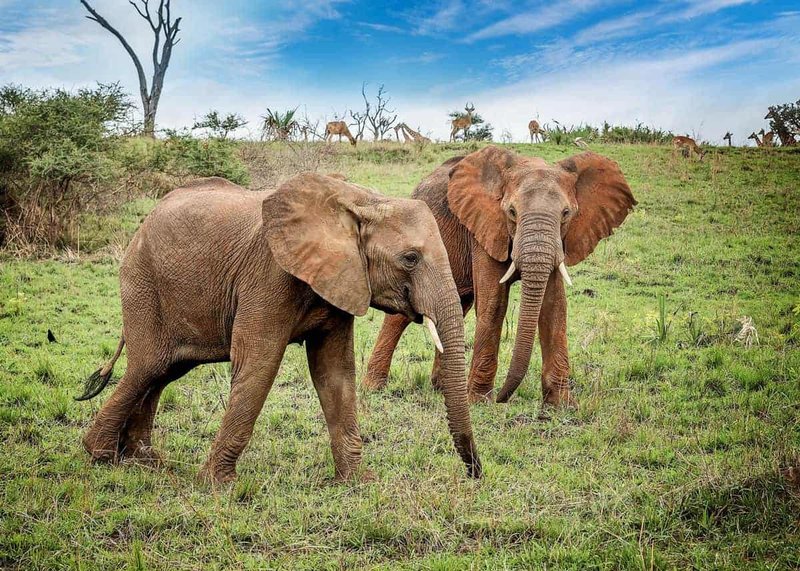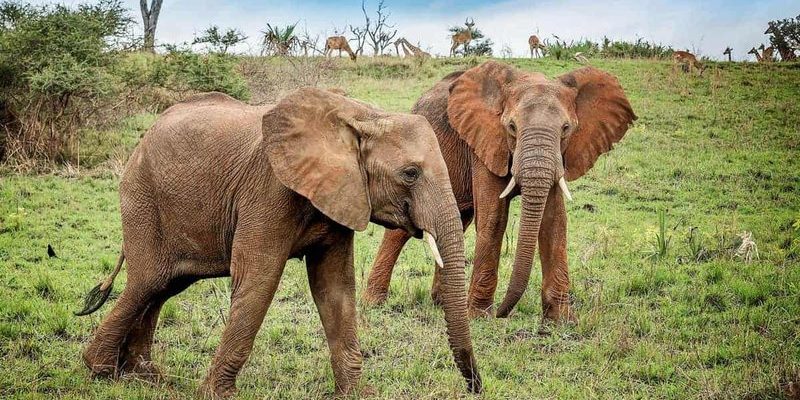
African bush elephants are the largest land animals on Earth, and they thrive in a variety of environments across Africa. Their habitat spans a wide range, from open savannahs and dense forests to wetlands and deserts. This adaptability is part of what makes them so fascinating! Picture it like a family gathering—some members prefer the bustling kitchen while others enjoy the quiet of the living room. Similarly, bush elephants find comfort in different landscapes based on what they need to survive.
What’s even more intriguing is that these elephants play a crucial role in their ecosystems. By knocking down trees, creating pathways, and digging water holes, they help shape the environment around them. Now, let’s explore their habitats more closely and see where these magnificent creatures live.
The Primary Habitat of African Bush Elephants
African bush elephants thrive mainly in savanna woodlands, which are characterized by a mix of grasslands and scattered trees. This habitat provides them with plenty of food, including grasses, shrubs, and the occasional bark from trees. Imagine walking through a park where you can pick fruit from trees while enjoying a picnic on the grass—that’s the kind of buffet these elephants have!
Interestingly, they are also found in mopane woodlands, where the mopane tree grows. This habitat is particularly popular in southern Africa, and it gives elephants access to essential nutrients. These trees are often stripped down to the branches by elephants, showcasing their strong foraging abilities.
Another significant habitat is the broadleaf forests found in certain regions of Central and West Africa. Though less common, these forests offer a different type of food source, including fruits and leaves. Here’s the thing: the availability of food shapes where these elephants live, ensuring they can sustain themselves all year round.
Geographical Distribution Across Africa
African bush elephants are primarily distributed across sub-Saharan Africa. If you were to trace a map of Africa, you’d find them in countries like Tanzania, Botswana, Zimbabwe, and South Africa. Each region offers unique environments and challenges.
For example, in Botswana’s Okavango Delta, you can witness elephants congregating near water sources, especially during the dry season. Imagine a bustling family reunion in a beautiful garden with a fresh water fountain—this is how these elephants interact during the hot months. They use their trunks to splash water and stay cool, showcasing their intelligence and social behavior.
In contrast, in Kenya, they roam the vast savannahs of the Maasai Mara, where they can often be spotted during the Great Migration. This area is like their playground, where they can graze all day, socialize with other elephants, and, of course, show off their size!
Impact of Seasonal Changes on Their Habitat
The habitats of African bush elephants are not static; they change with the seasons. During the rainy season, which typically runs from October to March, the landscape transforms. Vegetation flourishes, providing a feast for elephants. Think of it as an all-you-can-eat buffet opening up after a long wait—elephants thrive during this time.
However, during the dry season, food becomes scarce. Elephants must travel further distances to find adequate resources. This travel can lead them to more urbanized areas as they search for sustenance, leading to human-elephant conflicts. It’s a bit like a family trying to keep the holiday dinner from getting burnt while finding enough chairs for everyone to sit!
Threats to Their Habitat and Distribution
Unfortunately, African bush elephants face numerous threats that impact their habitats and distribution. Poaching is one of the biggest dangers, driven mainly by demand for ivory. This illegal activity not only reduces elephant populations but also disrupts their social structures. Think of it as losing key members of a family reunion—it changes everything.
Additionally, habitat loss due to deforestation and human expansion poses a significant threat. As more land is cleared for agriculture or urban development, elephants lose crucial feeding areas and migration paths. It’s heartbreaking to think of these magnificent creatures struggling to find their way in a landscape that’s changing so rapidly.
Human-elephant conflict also arises when elephants move into agricultural areas in search of food. This often leads to crops being destroyed, resulting in tension between farmers and elephants. Finding a balance is essential for both elephants and local communities to coexist.
Conservation Efforts and Future Solutions
To help protect African bush elephants and their habitats, numerous conservation efforts are underway. Organizations work to create protected areas where elephants can live safely and freely. These protected zones can be thought of as safe havens, much like how we secure our homes to ensure comfort and safety.
Another strategy involves working with local communities to promote human-elephant coexistence. Education and awareness programs can help farmers understand the importance of elephants in their ecosystems, encouraging them to protect rather than harm these gentle giants.
Innovative solutions, like using beehive fences to deter elephants from crops, have also gained traction. Elephants tend to avoid areas buzzing with bees, which helps protect agricultural lands without harming the elephants. It’s like having a natural alarm system that ensures both parties remain safe and healthy.
The Role of African Bush Elephants in Ecosystems
African bush elephants are often referred to as “ecosystem engineers.” Why? Because they play a vital role in shaping their surroundings. By uprooting trees, trampling down vegetation, and creating water holes, they make their environment more accessible for other animals. Here’s the thing: without them, the landscape would change dramatically, affecting various species that rely on these habitats.
For example, their foraging helps maintain the balance between grasses and woody plants in savannah ecosystems. This balance supports a diversity of wildlife, from antelopes to birds. Imagine a well-tended garden where each plant serves a purpose—this is what elephants help create in their ecosystems.
Moreover, their dung is a source of nutrients for the soil and an important food source for insects and other animals. It’s a full-circle moment: what elephants consume eventually nourishes the ecosystems that support countless other species.
Understanding where African bush elephants live and how they interact with their habitats is vital for their conservation and our own ability to appreciate these incredible animals. Their roaming presence across diverse landscapes helps shape ecosystems and maintain the balance of nature.
As habitats face threats from humans, it becomes increasingly important to support conservation efforts that protect these gentle giants and their homes. By recognizing their role in the environment, we can work together to ensure future generations get to marvel at the beauty of African bush elephants in their natural habitats. After all, protecting them means protecting a piece of our planet’s magic.

